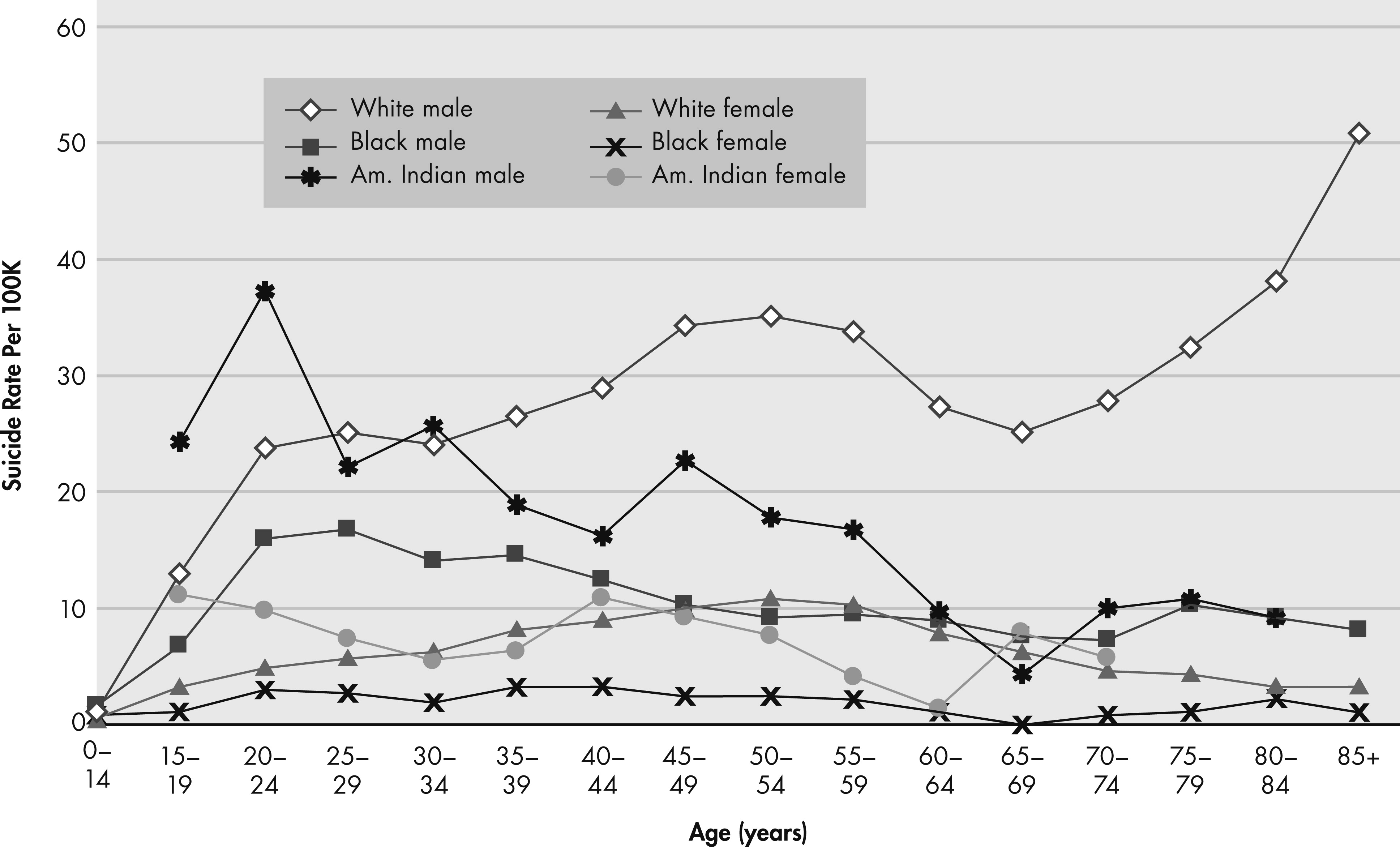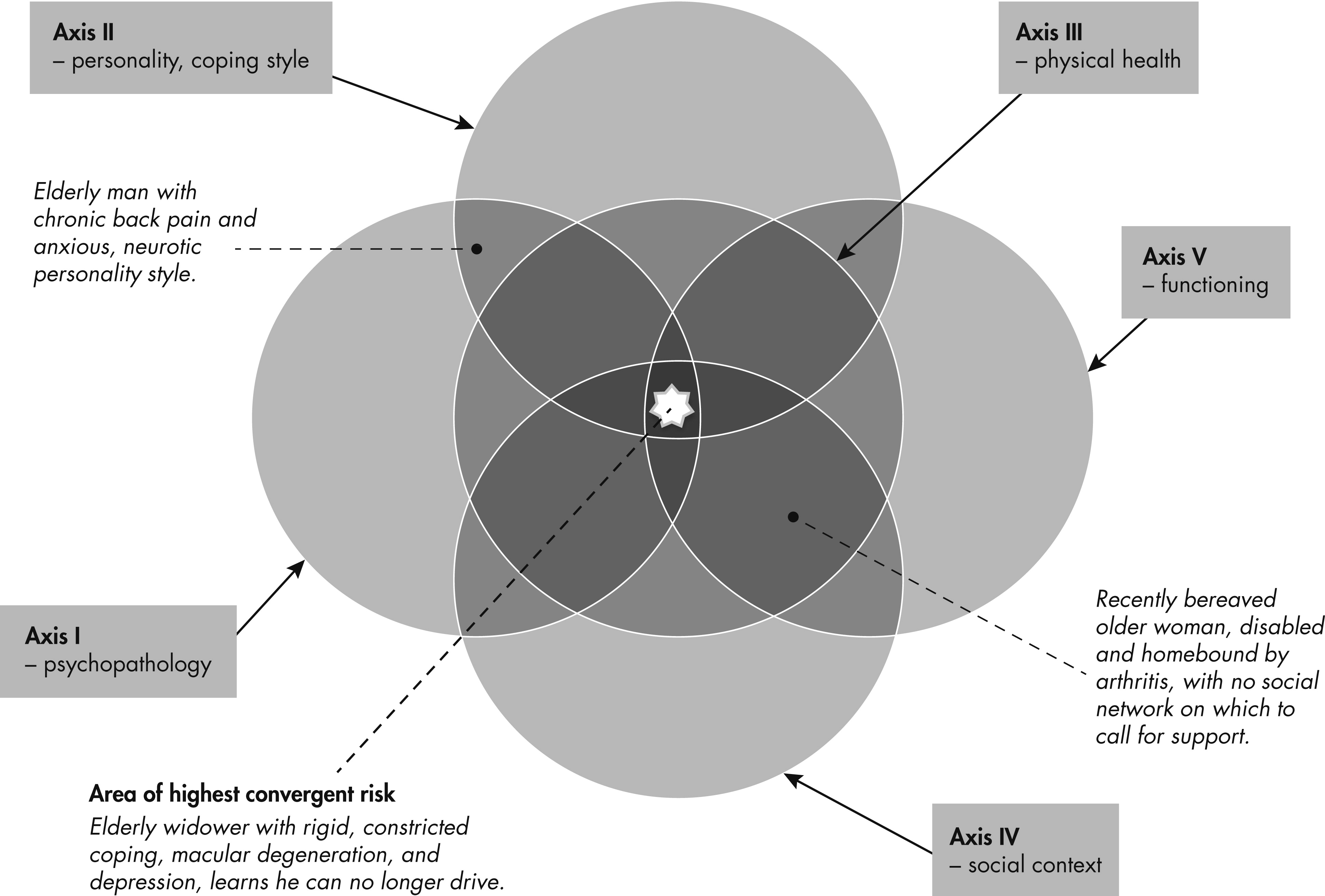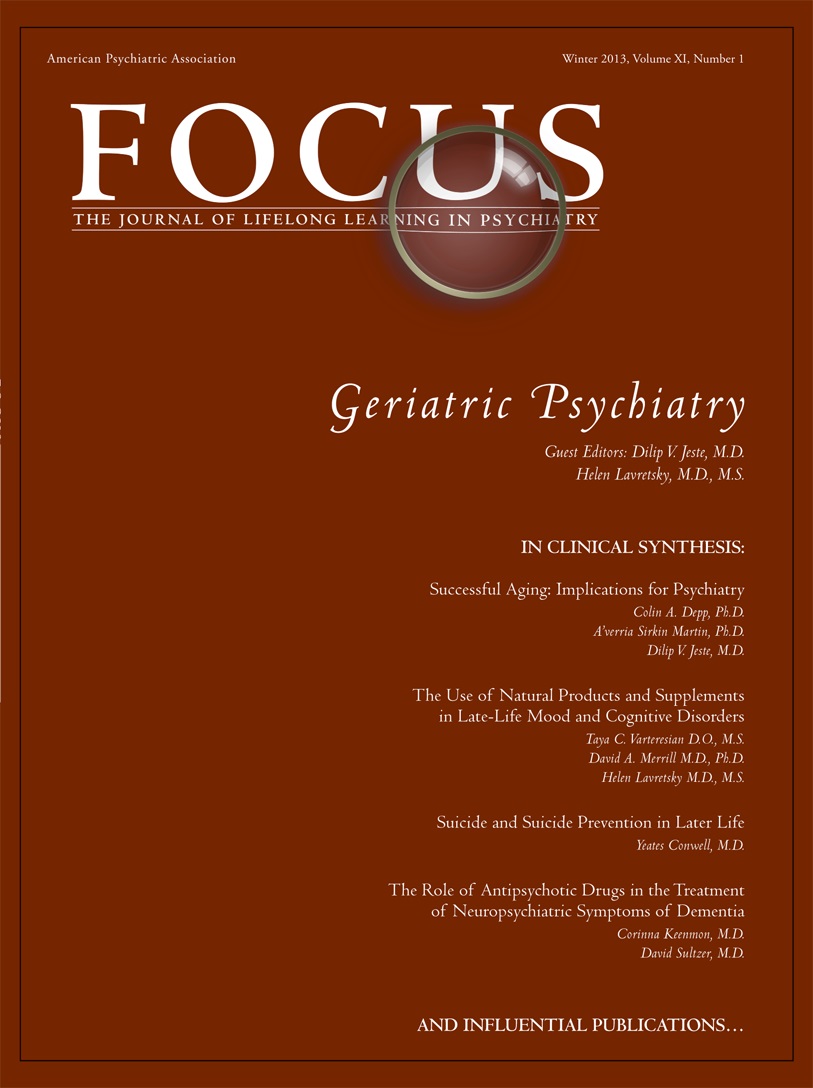Suicide and Suicide Prevention in Later Life
Abstract
Introduction
The epidemiology of suicide

Risk and protective factors

Axis I: major psychiatric illness
| Study | Number of Cases | Age | Gender (M/F) | Odds Ratios | ||||||||
|---|---|---|---|---|---|---|---|---|---|---|---|---|
| Suicides | Controls | Suicides | Controls | Any Axis I Diagnosis | Any Mood Disorder | Major Depressive Episode | Substance Use Disorder | Anxiety Disorder | Schizo-phrenic Spectrum | Dementia/Delirium | ||
| Harwood et al., 2001 (9) | 54 | 54 | ≥ 60 | n/a | n/a | -- | 4.0 | -- | n.s. | -- | n.s. | 0.2 |
| Beautrais, 2002 (10) | 53a | 269 | ≥ 55 | 27/26 | n/a | 43.9 | 184.6 | -- | 4.4 | -- | -- | -- |
| Waern et al., 2002 (11) | 85 | 153 | ≥ 65 | 46/39 | 84/69 | 113.1 | 63.1 | 28.6 | 43.1 | 3.6 | 10.7 | n.s. |
| Chiu et al., 2004 (12) | 70 | 100 | ≥ 60 | 32/38 | 43/57 | 50.0 | 59.2 | 36.3 | n.s. | n.s. | >1 | n.s. |
| Conwell et al., 2009 (13) | 86 | 86 | ≥ 50 | 63/23 | 63/23 | 44.6 | 47.7 | 12.2 | n.s. | 5.9 | n.s. | n.s. |
Axis II: personality and coping
Axis III: physical health
Axis IV: social context
Axis V: functional impairment
Other
Points of access
Preventive interventions
| Study | Study Design | Prevention Approacha | Intervention | Participants | Age | Outcome Assessed | Effectb |
|---|---|---|---|---|---|---|---|
| Unützer et al., 2006 (U.S.A.) (40) | Randomized controlled trial | Indicated | IMPACT: Primary care-based depression care management; tx algorithms; patient, family, provider education | 1801 with major depression/ dysthymia: 996 intervention, 895 controls | ≥ 60 | Suicidal ideation | Resolution of suicidal ideation: OR=0.7 (95% CI=0.4–0.8) |
| Alexopoulos et al., 2009; Bruce et al., 2004 (U.S.A.) (41) | Randomized controlled trial | Indicated | PROSPECT: Primary care-based depression care management; treatment algorithms; patient, family, provider education | 599 with mood disorders: 320 intervention, 279 controls | ≥ 60 | Suicidal ideation | For patients with major depression, resolution of suicidal ideation at 24 months: OR=3.2 (95% CI=1.1–9.5) |
| Heisel et al., 2009 (Canada) (42) | Case series | Indicated | IPT to improve social functioning + existing treatment | 11 referrals from clinicians/medical staff | ≥ 60 | Suicidal ideation | Pre/post reduction in suicidal ideation score: p=0.01 |
| Stone et al., 2009 (U.S.A.) (43) | Meta-analysis | Indicated | Antidepressant medications | 372 randomized, placebo-controlled trials, with 99,231 randomized subjects with affective disorders (50%) or other psychiatric conditions (50%) | ≥ 18 | Suicidal ideation (or behavior [14%]) | Decreasing risk of newly emerging suicidal ideation with age: <25 yrs: OR=1.62 (95% CI=0.97–2.71); 25–64: OR=0.79 (95% CI=0.64–0.98); ≥65: OR=0.37 (95% CI=0.18–0.76) |
| Oyama et al., 2008 (Japan) (47) | Meta-analysis | Multilevel | Depression screening, psychoeducation workshops, referral, follow-up, treatment by psychiatry or primary care | Five quasi-experimental studies comparing regions with and without intervention. Men: 20,598 person years; women: 28,437 person years | ≥ 65 | Suicide | Psychiatrist follow-up: men: IRR=0.3 (95% CI=0.1–0.7), women: IRR=0.3 (95% CI=0.2–0.6); GP follow-up: men: n.s., women: IRR=0.4 [0.2–0.6] |
| De Leo et al., 2002 (Italy) (45) | Ecological study | Selective | 24 hr. access to supports as needed; weekly phone contact | Men: 2,983 women: 15,658 | ≥ 65 | Suicide | For women, standardized mortality ratio=16.7% (2.0%–59.9%); for men: n.s. |
| Chan et al., 2011 (Hong Kong) (44) | Cohort study | Indicated | Primary care-based gatekeeper training, referral to geropsychiatry, care management, active aftercare for suicide attempters. | 351 suicide attempters received intervention (66 preintervention), all diagnoses | ≥ 65 | Suicide and suicide attempt | 2-year suicide rate: p=0.028; reattempt rates: p=n.s. |
| Ludwig & Cook, 2000 (U.S.A.) (46) | Ecological study | Universal | Relative change in handgun suicides in states that implemented gun control legislation versus those with no new policy implementation. | All 50 U.S. states, vital statistics data reports of suicides from 1985 through 1997 | All ages | Handgun suicides | Rate reduction per 100,000 population: −0.92 (95% CI=−1.43 to −0.42) for those ≥ 55 years. No difference for homicide rates or overall suicide rates. |
Studies of interventions that target suicidal ideation
Studies of interventions that target suicide and suicide attempts
Conclusions
Footnote
References
Information & Authors
Information
Published In
History
Authors
Funding Information
Metrics & Citations
Metrics
Citations
Export Citations
If you have the appropriate software installed, you can download article citation data to the citation manager of your choice. Simply select your manager software from the list below and click Download.
For more information or tips please see 'Downloading to a citation manager' in the Help menu.
View Options
View options
PDF/EPUB
View PDF/EPUBGet Access
Login options
Already a subscriber? Access your subscription through your login credentials or your institution for full access to this article.
Personal login Institutional Login Open Athens loginNot a subscriber?
PsychiatryOnline subscription options offer access to the DSM-5-TR® library, books, journals, CME, and patient resources. This all-in-one virtual library provides psychiatrists and mental health professionals with key resources for diagnosis, treatment, research, and professional development.
Need more help? PsychiatryOnline Customer Service may be reached by emailing [email protected] or by calling 800-368-5777 (in the U.S.) or 703-907-7322 (outside the U.S.).

